This is your go-to, ultimate guide to making perfect Gulab Jamun at home! These golden, soft, and juicy delights are everything a classic Indian dessert should be—rich in flavor, unbelievably soft, and so irresistibly melt-in-the-mouth that you’ll keep going back for more. Whether you’re making them for a festive celebration, a special occasion, or just to satisfy your sweet cravings, this foolproof recipe will never let you down.
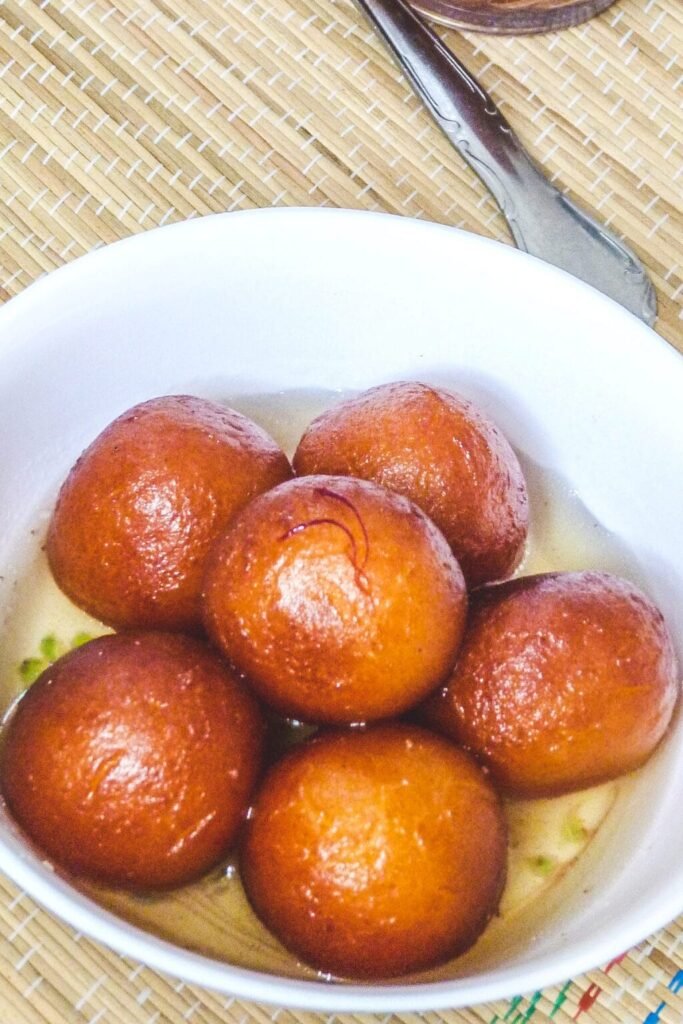
In this post, I’m sharing the traditional way of making gulab jamuns using khoya (mawa)—a time-honored ingredient that gives the jamuns their authentic texture and deep, milky richness. The result? Delicious, well-soaked dumplings that are soft from the inside and beautifully golden on the outside.
You’ll also find all the expert tips and tricks needed to master the art of gulab jamun making—how to knead the dough just right, how to avoid cracks, how to fry them evenly, and how to make the perfect sugar syrup that penetrates each piece with sweet, floral flavor.
This step-by-step recipe ensures that even beginners can create restaurant-style gulab jamuns at home—light, juicy, and with no greasy aftertaste. No complicated methods, no mix packets—just a simple, tried-and-true technique that’s been used in Indian kitchens for generations.
What Is Gulab Jamun?
Gulab Jamun is one of the most cherished and iconic Indian desserts, loved for its rich flavor and melt-in-the-mouth texture. These soft, golden-brown dumplings made from reduced milk solids are gently fried until they achieve a perfect golden hue and then soaked in a warm, aromatic sugar syrup infused with saffron, cardamom, and rose water. As the jamuns rest in the syrup, they absorb its floral sweetness and become irresistibly soft, juicy, and flavorful.
Ever wondered how this decadent dessert got its name? ‘Gulab’ means rose in Hindi, a nod to the fragrant rose water that gives the sugar syrup its signature floral aroma. “Jamun” is the name of a small, dark purple Indian fruit (Java plum or black plum), which the shape, size, and color of the dessert closely resemble—hence the name Gulab Jamun.
These classic sweets are traditionally prepared with khoya (or mawa), a thickened milk solid that lends gulab jamuns their rich taste and signature dense texture. However, there’s also a modern version made with milk powder, which is a convenient alternative when khoya isn’t readily available. Both versions are equally delicious when prepared right, though khoya remains the classic choice.
Gulab Jamuns are especially popular during Indian festivals like Diwali, Holi, Eid, and Raksha Bandhan, as well as on weddings, birthdays, or any celebratory occasion. While many prefer buying them from sweet shops, I find joy in making them at home. It not only ensures the use of fresh, high-quality ingredients but also guarantees hygiene and care in every bite.
Whether you’re new to Indian sweets or a lifelong fan, homemade gulab jamun is a must-try experience—deeply satisfying and utterly indulgent.
Ingredients:
Below is a detailed look at the essential ingredients needed to make this decadent and authentic gulab jamun recipe. All are easy to find, especially if you frequently cook Indian sweets. You’ll need a total of 8 ingredients, plus ghee or oil for deep frying (not shown in the picture).
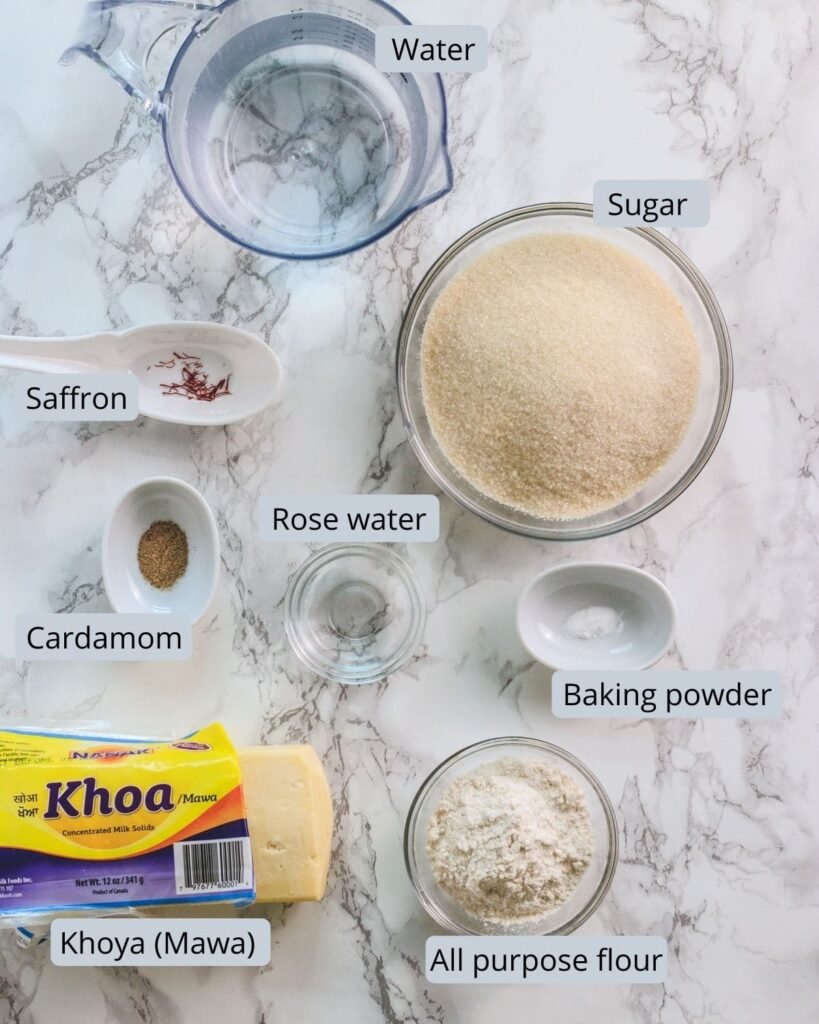
- Khoya (Mawa): This is the star ingredient that forms the base of traditional gulab jamun. Khoya is nothing but milk that has been simmered and reduced to a solid mass. In India, fresh khoya is widely available at local dairy shops. If making at home, use homemade khoya for the freshest flavor and soft texture.
- All-Purpose Flour (Maida): Just a small amount of all-purpose flour is added to act as a binding agent. It helps hold the dough together while forming smooth, crack-free balls.
- Cardamom Powder: For flavoring, we use ground green cardamom. To prepare, lightly crush the pods to separate the seeds, then grind the seeds into a fine powder using a mortar and pestle. This spice adds a sweet, floral note to the syrup and jamuns.
- Rose Water: A few drops of rose water add a delightful fragrance and traditional floral essence to the sugar syrup, giving gulab jamun its characteristic aroma.
- Saffron Strands (Optional): Though not essential, saffron lends a luxurious touch to the syrup with its delicate flavor and golden hue. It’s especially ideal for festive occasions.
- Sugar, Water & Lemon Juice: Essential for preparing the sweet syrup in which the jamuns are soaked to absorb flavor and moisture. Lemon juice prevents crystallization of sugar.
- Ghee or Oil: For deep frying the jamun balls to golden perfection. Ghee brings a rich, authentic taste to the fried jamuns, while oil offers a milder, lighter alternative for those preferring a less heavy option.
How To Make Gulab Jamun?
Making Gulab Jamun Dough & Balls
1) If you’re using frozen khoya, ensure it is fully thawed before beginning. Grate the khoya and measure it by gently pressing it into a measuring cup to get an accurate quantity.
2) Place grated khoya, all-purpose flour, baking powder, and cardamom powder into a mixing bowl and combine them thoroughly.
3) Mix everything together gently using your fingertips. The mixture should begin to clump and hold together when pressed.
4) If using frozen khoya like I did, you may need to add water gradually—one teaspoon at a time to bind the mixture into a dough. Do not knead the dough, just gather it gently until it comes together.
– If using fresh khoya, it may already contain more moisture. You might not need water at all. If the mixture becomes too wet or sticky, adjust by adding a small amount of flour until it holds its shape.
Always adjust water or flour depending on the moisture level of your khoya.
5) Once the dough is ready, divide it into 22 equal portions and gently shape each one into a smooth, crack-free ball. Avoid pressing or over-rolling.
6) Cover the dough balls with a clean kitchen towel to keep them from drying out while you prepare the syrup.
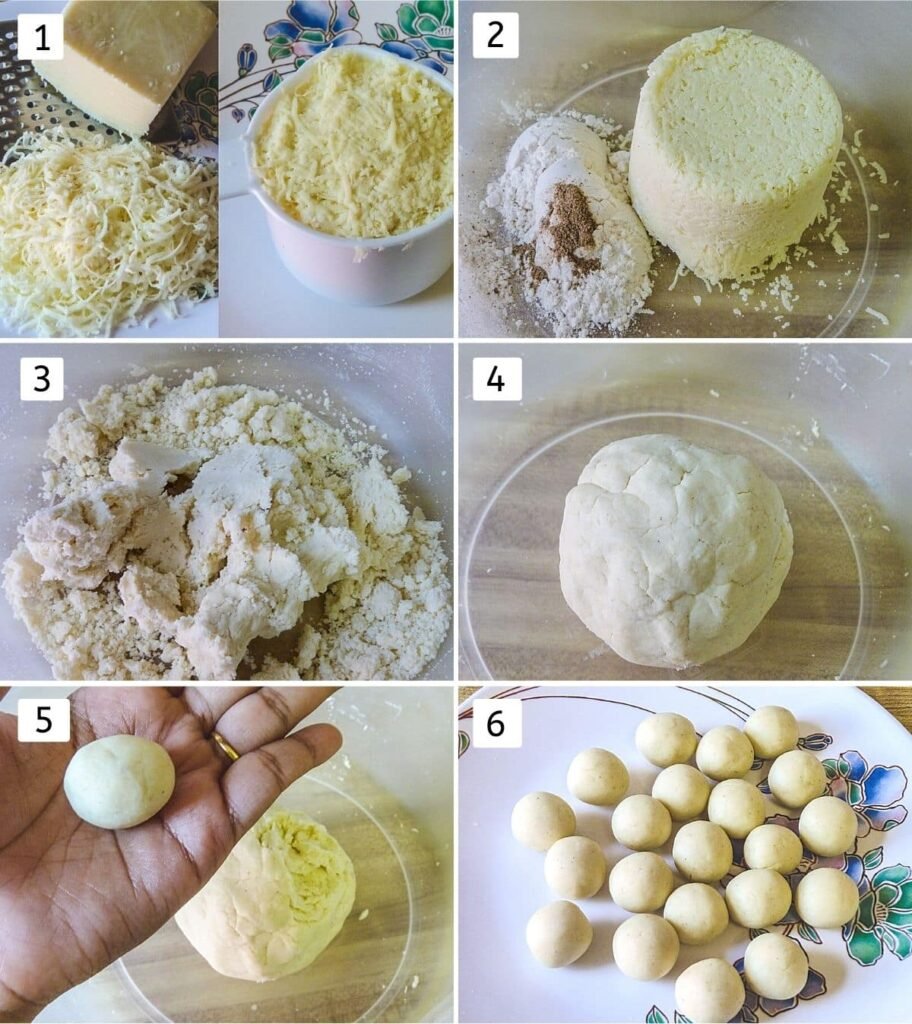
Making the Sugar Syrup
7) In a deep, wide saucepan, add sugar, cardamom pods, saffron strands, and water. Turn the heat to medium and allow the mixture to come to a boil.
8) Once it starts boiling, reduce the heat and let it simmer gently for 4–5 minutes. The syrup should have a slightly sticky texture—no thread consistency is needed. Remove the syrup from the heat and gently mix in the rose water to infuse it with a delicate floral aroma. Set aside.

Frying and Soaking the Gulab Jamuns
- Warm ghee or oil in a deep, heavy-bottomed pan on medium-low flame until it reaches the right frying temperature. For the most authentic taste, use ghee, but neutral oil can also be used for a lighter version.
- To test the oil temperature, drop a small pinch of dough in the oil—it should sink briefly and then rise slowly. If the dough piece floats to the surface immediately, the oil is overheated and needs to be cooled slightly.
- Add one test ball first. If it cracks or breaks, incorporate a little more flour into the dough and reshape the balls.
9) Carefully place a few gulab jamun balls into the oil at a time. Do not overcrowd the pan.
10) Once light golden spots begin to appear, start turning them gently to ensure even browning. Fry on medium-low heat until they turn uniformly deep golden brown. Adjust the flame as needed to maintain a steady oil temperature. High heat can result in dark outsides with undercooked centers.
11) Remove the fried balls with a slotted spoon and transfer them to a plate lined with paper towels. Let them rest for 5 minutes—this prevents them from breaking when added to the syrup.
12) If your syrup has cooled, warm it slightly. Then gently drop the lukewarm gulab jamuns into the warm syrup. The jamuns will float if properly cooked. If they sink, they may be too dense or undercooked inside. Allow them to soak for 3–4 hours, during which they will absorb the syrup, expand in size, and become soft and juicy.
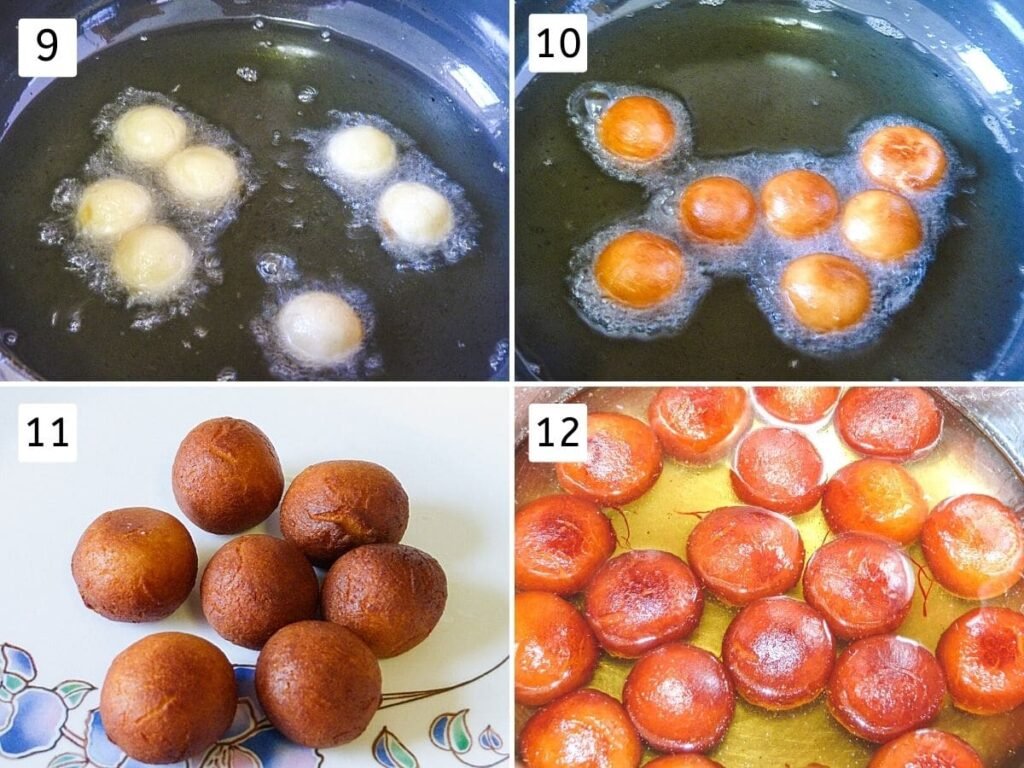
Expert Tips To Make Perfect Gulab Jamun
Dough Making Tips:
- Measure with precision: Always use a measuring spoon for baking powder. Excess baking powder may cause the gulab jamuns to disintegrate during frying.
- Avoid kneading: Simply mix and gather the dough into a soft mass. Over-kneading results in dense and hard jamuns.
- Use finely grated khoya: Avoid using coarsely crumbled khoya, as it creates a gritty texture. Grating ensures a smoother dough and prevents the need for excessive handling.
- Adjust moisture based on khoya type: Frozen khoya tends to be drier and may need a few drops of water to bind. Fresh khoya often contains more moisture, so water may not be necessary, though you might need to add a touch more flour for balance.
Gulab Jamun Ball Shaping Tips:
- Uniform size matters: Divide the dough evenly to ensure consistent frying and even texture.
- Smooth surface is key: Roll each ball gently until smooth and crack-free to prevent them from splitting in the oil.
- Keep covered: While preparing other steps, cover the shaped balls with a damp cloth or clean kitchen towel to keep them from drying out.
Sugar Syrup Tips:
- Sticky, not stringy: Simmer the syrup for 4–5 minutes after boiling. You’re aiming for a slightly sticky consistency—no thread formation needed.
- Avoid overly thick syrup: A dense syrup won’t be absorbed well. Keep it light so the jamuns can soak properly.
- It thickens as it cools: Don’t panic if it looks thin initially; it will naturally thicken once it cools down.
Frying Tips:
- Oil should be moderately hot: Not smoking hot like for fritters. The right temperature ensures even cooking.
- Fry slowly and gently: Use medium-low heat. High temperatures will brown the outside quickly while leaving the inside raw.
- To check the oil temperature, drop a tiny piece of dough into the pan—it should sink briefly, then rise slowly to the surface. If it sinks and then rises gradually, the temperature is just right. If it floats up instantly, it’s too hot.
- Be patient: Each batch takes time to cook properly due to the lower frying temperature, but the result is worth it.
- Soaking Tips:
- Warm syrup is best: Add the jamuns to syrup that is warm, not hot, and not cold. Hot syrup can cause them to deflate, while cold syrup prevents absorption.
- Let excess oil drain: After frying, place the jamuns on paper towels and let them sit for a few minutes before transferring them to the syrup.
- Allow enough soaking time: Let the jamuns rest in the syrup for at least 3–4 hours to absorb maximum flavor and become soft and juicy.
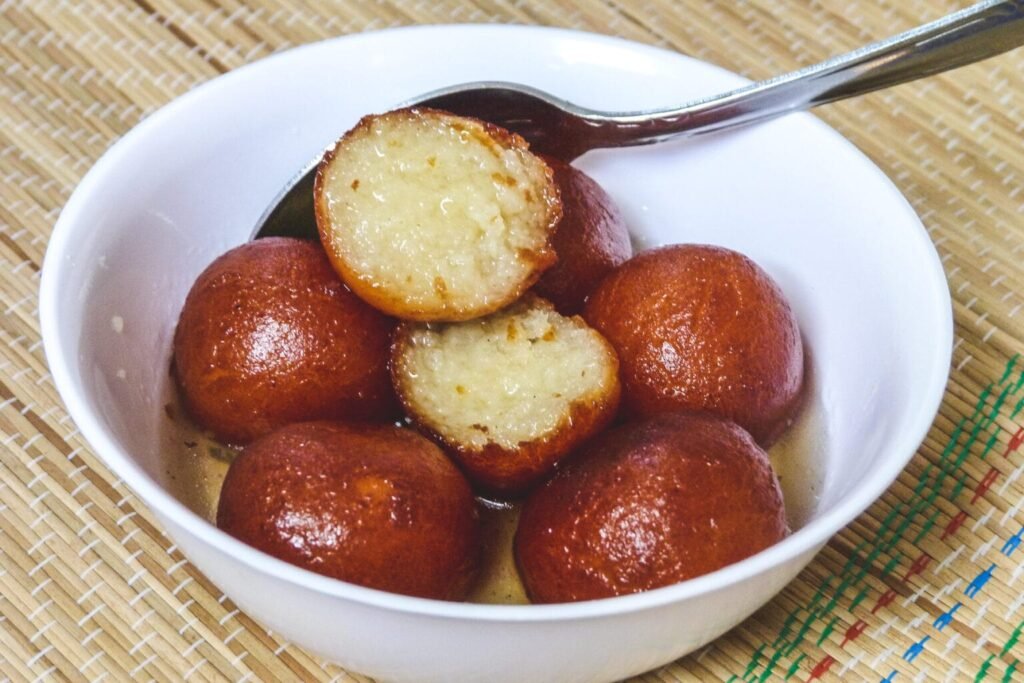
Serving Ideas:
- Serve as You Like – Warm, Cold, or Room Temp: Gulab jamuns can be enjoyed warm, chilled, or at room temperature—go with what your taste buds prefer. To serve warm, gently microwave for a few seconds until just heated.
- As a Classic Dessert: Serve these soft, juicy delights after a festive meal or even during the meal as a traditional Indian sweet treat.
- With Rabdi for a Royal Twist: Drain the excess syrup and cut each gulab jamun in half. Arrange the halves neatly on a dessert platter. Pour chilled rabdi (thickened sweet milk) over them and finish with a garnish of sliced almonds or pistachios.
- With Whipped Cream (Modern Take): Replace rabdi with mildly sweetened whipped cream for a modern, fusion-style twist on this traditional dessert. It’s a lighter alternative with a creamy finish.
- Rolled in Coconut or Nut Powder: For a dry version, let the syrup drain off and roll each gulab jamun in desiccated coconut or powdered nuts (like almond or cashew). This adds a nutty crunch and makes for beautiful plating.
- Drizzled with Chocolate Sauce: Looking for a Western twist? Pour over warm chocolate ganache or drizzle chocolate sauce on the gulab jamuns and sprinkle with crushed pistachios for a rich, decadent dessert.
